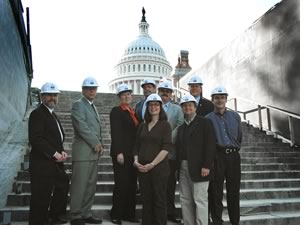

11/2005
While convening in Washington, D.C, members of the AIA Executive Committee toured the construction site of the new U.S. Capitol Visitor Center on October 19 with the best of all possible tour guides: Architect of the Capitol Alan Hantman, FAIA. Construction of the visitor center began in July 2002 for the purpose of making the Capitol “more accessible, comfortable, secure, and informative for all visitors.” Architecture firm RTKL Associates Inc. placed the facility underground below the East Capitol grounds, so as not to detract from the venerable appearance of the Capitol and its historic Frederick Law Olmsted landscape.
 Encompassing 580,000 square feet on three levels, the new visitor center
is nearly three-quarters the size of the Capitol itself and includes
space for two orientation theaters, an auditorium, exhibits, gift shops,
food service, security and other ancillary spaces, as well much needed
space for the House and Senate. Working in the days following the terrorist
attacks on September 11, 2001, RTKL designed the visitor center to enhance
security while preserving an atmosphere of free and open access, using
such processional elements as gently sloping ramps. Six skylights in
the center’s roof deck welcome sunlight to flood interior spaces
while offering visitors dramatic views of the Capitol dome.
Encompassing 580,000 square feet on three levels, the new visitor center
is nearly three-quarters the size of the Capitol itself and includes
space for two orientation theaters, an auditorium, exhibits, gift shops,
food service, security and other ancillary spaces, as well much needed
space for the House and Senate. Working in the days following the terrorist
attacks on September 11, 2001, RTKL designed the visitor center to enhance
security while preserving an atmosphere of free and open access, using
such processional elements as gently sloping ramps. Six skylights in
the center’s roof deck welcome sunlight to flood interior spaces
while offering visitors dramatic views of the Capitol dome.
Exceptional, focused vision
“All great projects require the collaboration of many individuals
to achieve success. The Congress and congressional leadership provided
an exceptional, focused vision for the project; the architect (RTKL) creatively
integrated the complex functions with a clear vision; and the contractors
appear to be executing the design details with superb craftsmanship,” noted
AIA President Douglas L Steidl, FAIA, in a letter of appreciation to Hartman. “As
the Architect of the Capitol, you have obviously excelled in unifying the
team effort, ensuring that the visionary ideals were adroitly integrated
with functional demands. Further, your team is well on its way to achieving
the significant architectural distinction that is worthy of this historic
and celebrated site.”
Construction, resolutely on track for a fall 2006 completion, is entering its final phase. Board members saw interior crews busily installing MEP systems, erecting interior walls, and hooking up fire and life-safety systems. Stone masons currently are installing some of the $35 million worth of finish stone, including in the Great Hall and the center’s two theaters. Outside, on the roof deck, historic preservation contractors are re-installing the original Olmsted-designed lanterns, fountains, and seat walls that had been temporarily stored during excavation and construction.
 Steidl, on behalf of the AIA’s 76,000 members, expressed gratitude
to the Architect of the Capitol “for shepherding this most vital
public project in such a manner that it is being exceptionally well constructed,
despite the most difficult of technical, environmental, schedule, and
iconic demands.” He further wrote to Hantman, “We believe
you deserve the gratitude of every American for ‘doing it right.’ The
excellence of this project is consistent with the significance of the ‘place’ and
will serve the citizens of this country extremely well, long into the
future.”
Steidl, on behalf of the AIA’s 76,000 members, expressed gratitude
to the Architect of the Capitol “for shepherding this most vital
public project in such a manner that it is being exceptionally well constructed,
despite the most difficult of technical, environmental, schedule, and
iconic demands.” He further wrote to Hantman, “We believe
you deserve the gratitude of every American for ‘doing it right.’ The
excellence of this project is consistent with the significance of the ‘place’ and
will serve the citizens of this country extremely well, long into the
future.”
Building bridges on the Hill
In the same week, in the nearby Hart Senate Office Building, Duane A.
Kell, FAIA, Ankeny Kell Architects, PA, St. Paul, and AIA Executive
Vice President/CEO Norman L. Koonce, FAIA, paid a visit to Senator
Norman Coleman (R.-Minn.). Kell, who first came to know the senator
during Coleman’s term as mayor of St. Paul, brought regards from
the Minnesota components of the AIA and thanked the senator for his
help in protecting Community Development Block Grants.
Kell and Koonce discussed public advocacy for public buildings with Sen. Coleman, and explained to him the Institute’s legislative initiatives that, if enacted, would offer appropriate and cost-effective assistance to those affected by the devastation of hurricanes Katrina and Rita. “Both Duane and I came away from our meeting convinced that Senator Coleman has the keen insights and experience to take a leadership role in the Senate as a spirited advocate for design excellence in the public sector,” Koonce said. Koonce and Kell both thanked AIA Minnesota Executive Director Beverly Hauschild-Baron, Hon. AIA, for her valuable assistance in arranging the visit.
In a follow-up visit, the senator’s staff and members of the AIA’s Government Advocacy staff agreed to explore development of Senate legislation on federal tax credits for historic preservation that is like the English-Jefferson bill in the House. It would be introduced during the second session of the 109th Congress.
Copyright 2005 The American Institute of Architects.
All rights reserved. Home Page ![]()
![]()
 |
||
|
||